University Case Study: Boeing 787 Dreamliner Logistics and Management
VerifiedAdded on 2022/08/14
|5
|870
|14
Case Study
AI Summary
The case study on Boeing 787 Dreamliner Logistics analyzes the importance of scheduling, quality, and supply chain management in large-scale projects. It examines how Boeing faced challenges related to quality issues, integration problems, and supplier management, which led to schedule slippages and cost overruns. The study explores Boeing's attempts to use modern technology and quality methods like ISO 9001 and Six Sigma. It highlights lessons learned, such as the critical need for coordination and integration across the supply chain. The analysis also discusses management errors, including the failure to partner with reliable suppliers, and the impact of these errors on project success. The case concludes by emphasizing the essential aspects of quality, scheduling, and supply chain management in project completion and underscores the importance of using technology to improve performance.
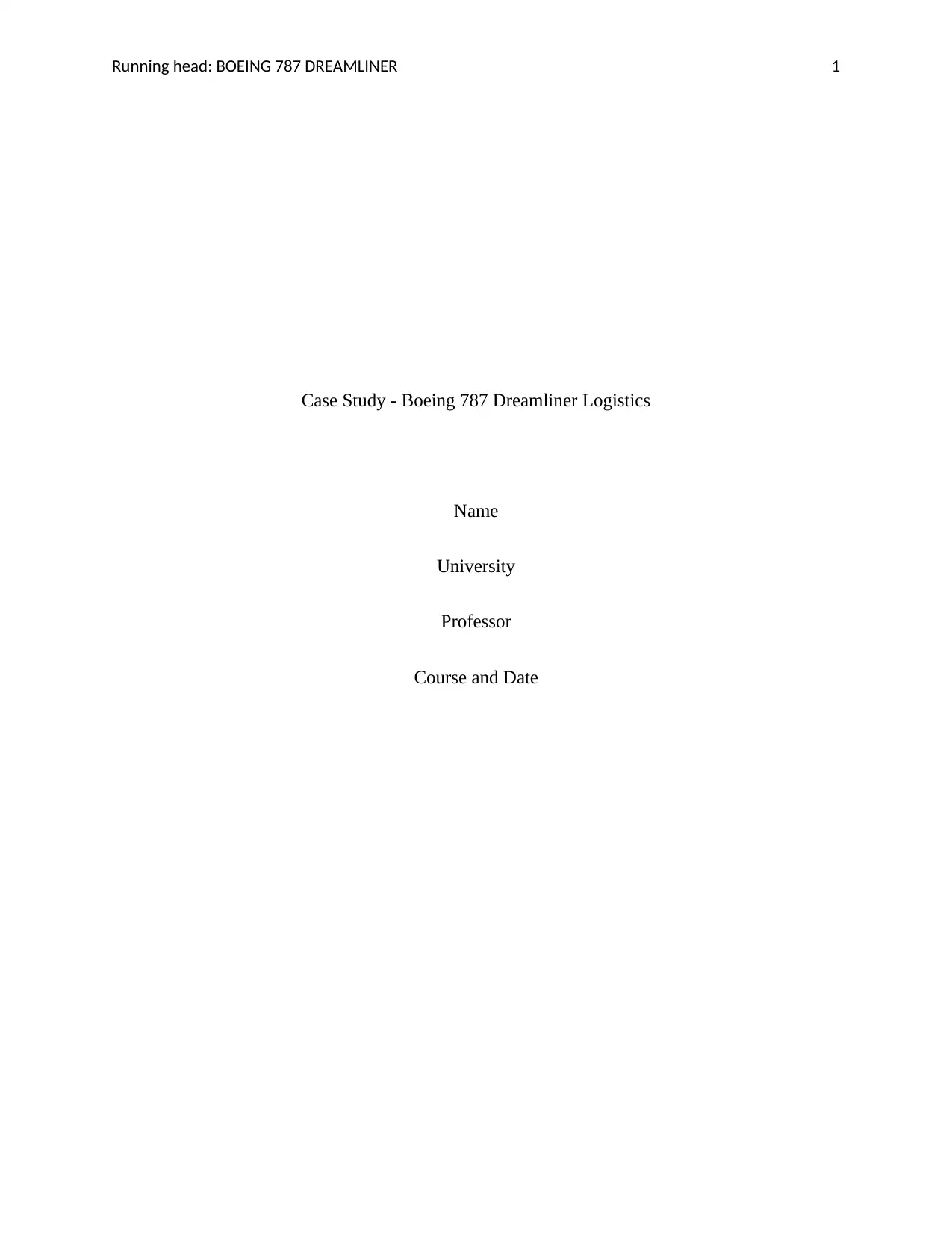
Running head: BOEING 787 DREAMLINER 1
Case Study - Boeing 787 Dreamliner Logistics
Name
University
Professor
Course and Date
Case Study - Boeing 787 Dreamliner Logistics
Name
University
Professor
Course and Date
Paraphrase This Document
Need a fresh take? Get an instant paraphrase of this document with our AI Paraphraser
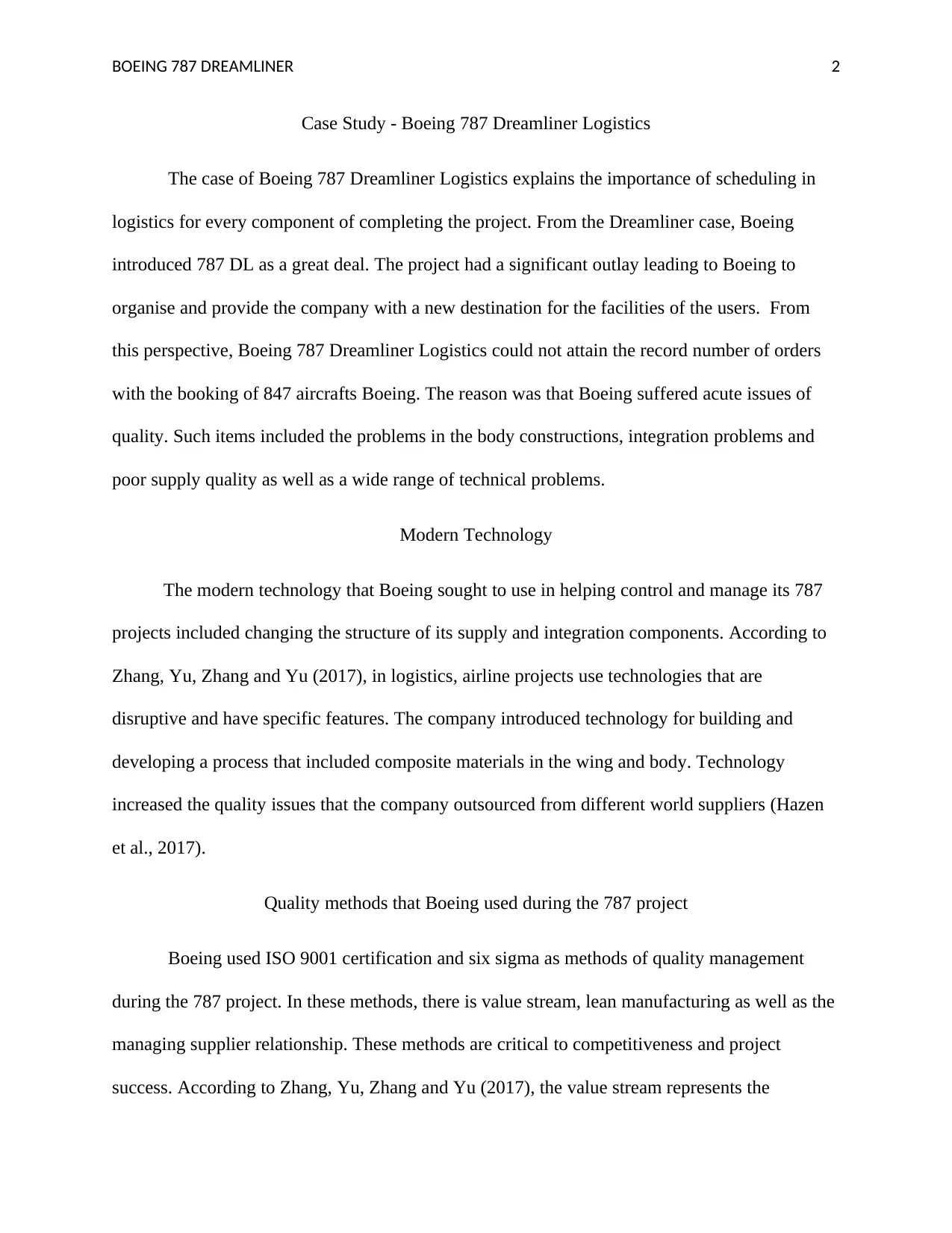
BOEING 787 DREAMLINER 2
Case Study - Boeing 787 Dreamliner Logistics
The case of Boeing 787 Dreamliner Logistics explains the importance of scheduling in
logistics for every component of completing the project. From the Dreamliner case, Boeing
introduced 787 DL as a great deal. The project had a significant outlay leading to Boeing to
organise and provide the company with a new destination for the facilities of the users. From
this perspective, Boeing 787 Dreamliner Logistics could not attain the record number of orders
with the booking of 847 aircrafts Boeing. The reason was that Boeing suffered acute issues of
quality. Such items included the problems in the body constructions, integration problems and
poor supply quality as well as a wide range of technical problems.
Modern Technology
The modern technology that Boeing sought to use in helping control and manage its 787
projects included changing the structure of its supply and integration components. According to
Zhang, Yu, Zhang and Yu (2017), in logistics, airline projects use technologies that are
disruptive and have specific features. The company introduced technology for building and
developing a process that included composite materials in the wing and body. Technology
increased the quality issues that the company outsourced from different world suppliers (Hazen
et al., 2017).
Quality methods that Boeing used during the 787 project
Boeing used ISO 9001 certification and six sigma as methods of quality management
during the 787 project. In these methods, there is value stream, lean manufacturing as well as the
managing supplier relationship. These methods are critical to competitiveness and project
success. According to Zhang, Yu, Zhang and Yu (2017), the value stream represents the
Case Study - Boeing 787 Dreamliner Logistics
The case of Boeing 787 Dreamliner Logistics explains the importance of scheduling in
logistics for every component of completing the project. From the Dreamliner case, Boeing
introduced 787 DL as a great deal. The project had a significant outlay leading to Boeing to
organise and provide the company with a new destination for the facilities of the users. From
this perspective, Boeing 787 Dreamliner Logistics could not attain the record number of orders
with the booking of 847 aircrafts Boeing. The reason was that Boeing suffered acute issues of
quality. Such items included the problems in the body constructions, integration problems and
poor supply quality as well as a wide range of technical problems.
Modern Technology
The modern technology that Boeing sought to use in helping control and manage its 787
projects included changing the structure of its supply and integration components. According to
Zhang, Yu, Zhang and Yu (2017), in logistics, airline projects use technologies that are
disruptive and have specific features. The company introduced technology for building and
developing a process that included composite materials in the wing and body. Technology
increased the quality issues that the company outsourced from different world suppliers (Hazen
et al., 2017).
Quality methods that Boeing used during the 787 project
Boeing used ISO 9001 certification and six sigma as methods of quality management
during the 787 project. In these methods, there is value stream, lean manufacturing as well as the
managing supplier relationship. These methods are critical to competitiveness and project
success. According to Zhang, Yu, Zhang and Yu (2017), the value stream represents the
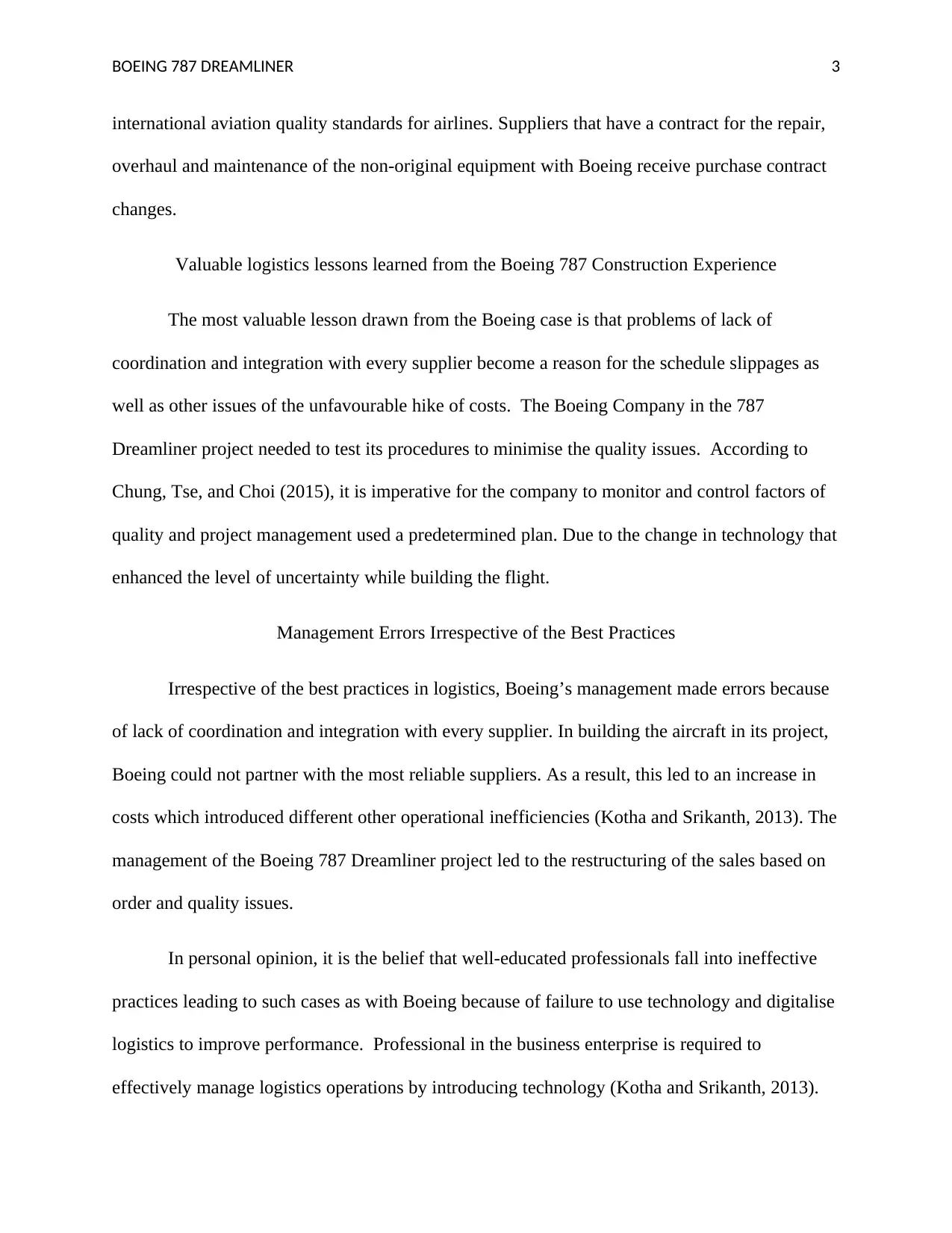
BOEING 787 DREAMLINER 3
international aviation quality standards for airlines. Suppliers that have a contract for the repair,
overhaul and maintenance of the non-original equipment with Boeing receive purchase contract
changes.
Valuable logistics lessons learned from the Boeing 787 Construction Experience
The most valuable lesson drawn from the Boeing case is that problems of lack of
coordination and integration with every supplier become a reason for the schedule slippages as
well as other issues of the unfavourable hike of costs. The Boeing Company in the 787
Dreamliner project needed to test its procedures to minimise the quality issues. According to
Chung, Tse, and Choi (2015), it is imperative for the company to monitor and control factors of
quality and project management used a predetermined plan. Due to the change in technology that
enhanced the level of uncertainty while building the flight.
Management Errors Irrespective of the Best Practices
Irrespective of the best practices in logistics, Boeing’s management made errors because
of lack of coordination and integration with every supplier. In building the aircraft in its project,
Boeing could not partner with the most reliable suppliers. As a result, this led to an increase in
costs which introduced different other operational inefficiencies (Kotha and Srikanth, 2013). The
management of the Boeing 787 Dreamliner project led to the restructuring of the sales based on
order and quality issues.
In personal opinion, it is the belief that well-educated professionals fall into ineffective
practices leading to such cases as with Boeing because of failure to use technology and digitalise
logistics to improve performance. Professional in the business enterprise is required to
effectively manage logistics operations by introducing technology (Kotha and Srikanth, 2013).
international aviation quality standards for airlines. Suppliers that have a contract for the repair,
overhaul and maintenance of the non-original equipment with Boeing receive purchase contract
changes.
Valuable logistics lessons learned from the Boeing 787 Construction Experience
The most valuable lesson drawn from the Boeing case is that problems of lack of
coordination and integration with every supplier become a reason for the schedule slippages as
well as other issues of the unfavourable hike of costs. The Boeing Company in the 787
Dreamliner project needed to test its procedures to minimise the quality issues. According to
Chung, Tse, and Choi (2015), it is imperative for the company to monitor and control factors of
quality and project management used a predetermined plan. Due to the change in technology that
enhanced the level of uncertainty while building the flight.
Management Errors Irrespective of the Best Practices
Irrespective of the best practices in logistics, Boeing’s management made errors because
of lack of coordination and integration with every supplier. In building the aircraft in its project,
Boeing could not partner with the most reliable suppliers. As a result, this led to an increase in
costs which introduced different other operational inefficiencies (Kotha and Srikanth, 2013). The
management of the Boeing 787 Dreamliner project led to the restructuring of the sales based on
order and quality issues.
In personal opinion, it is the belief that well-educated professionals fall into ineffective
practices leading to such cases as with Boeing because of failure to use technology and digitalise
logistics to improve performance. Professional in the business enterprise is required to
effectively manage logistics operations by introducing technology (Kotha and Srikanth, 2013).
⊘ This is a preview!⊘
Do you want full access?
Subscribe today to unlock all pages.

Trusted by 1+ million students worldwide
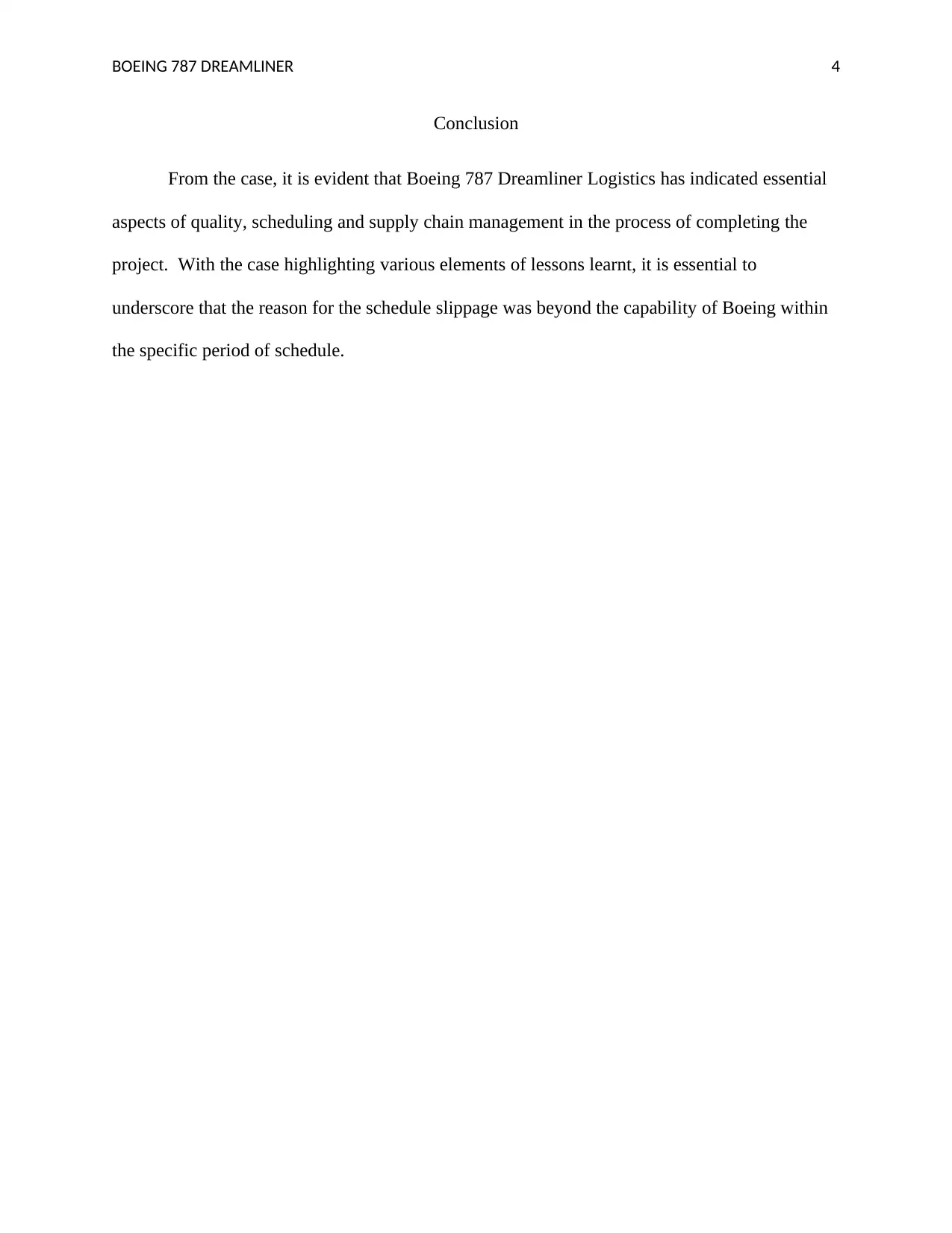
BOEING 787 DREAMLINER 4
Conclusion
From the case, it is evident that Boeing 787 Dreamliner Logistics has indicated essential
aspects of quality, scheduling and supply chain management in the process of completing the
project. With the case highlighting various elements of lessons learnt, it is essential to
underscore that the reason for the schedule slippage was beyond the capability of Boeing within
the specific period of schedule.
Conclusion
From the case, it is evident that Boeing 787 Dreamliner Logistics has indicated essential
aspects of quality, scheduling and supply chain management in the process of completing the
project. With the case highlighting various elements of lessons learnt, it is essential to
underscore that the reason for the schedule slippage was beyond the capability of Boeing within
the specific period of schedule.
Paraphrase This Document
Need a fresh take? Get an instant paraphrase of this document with our AI Paraphraser
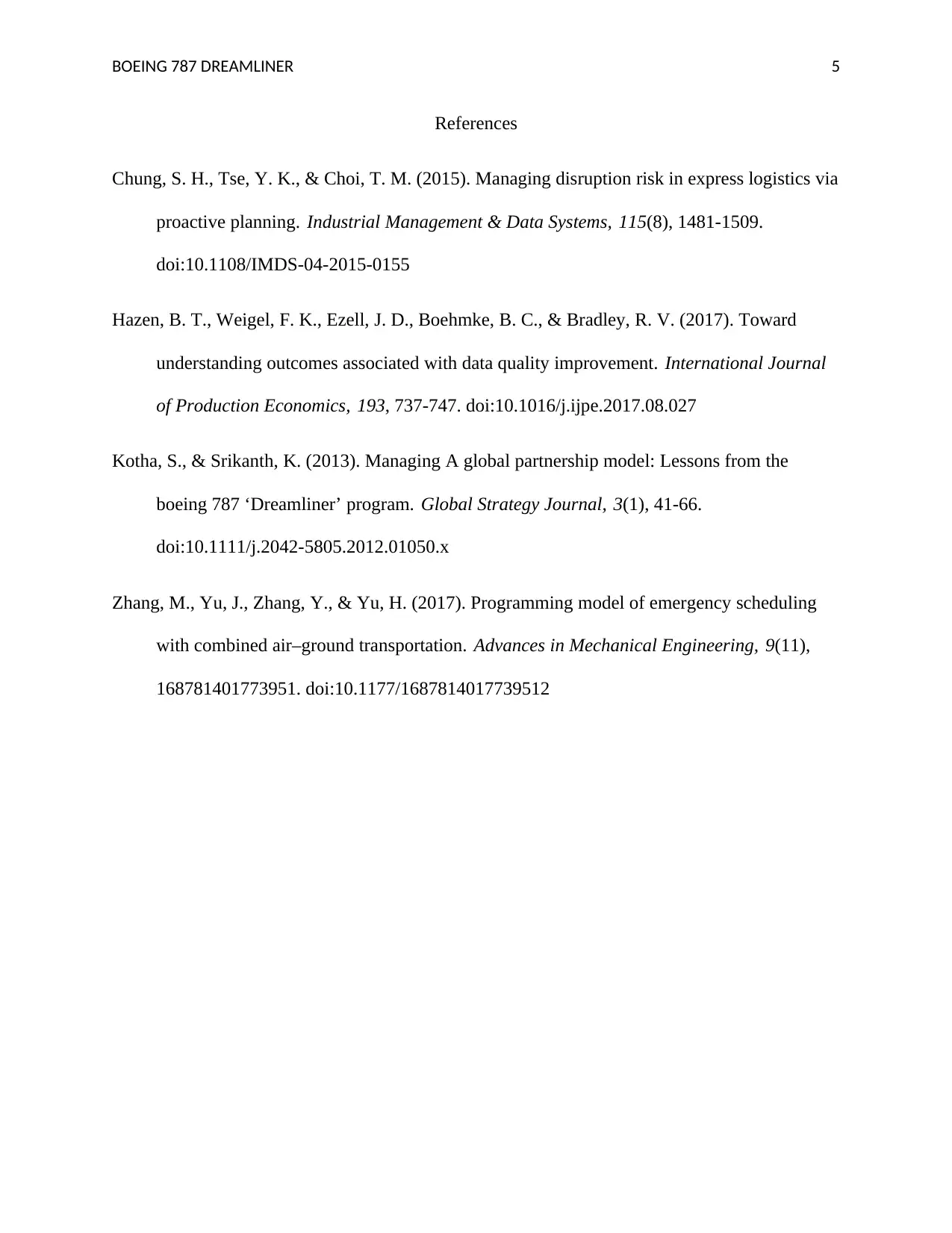
BOEING 787 DREAMLINER 5
References
Chung, S. H., Tse, Y. K., & Choi, T. M. (2015). Managing disruption risk in express logistics via
proactive planning. Industrial Management & Data Systems, 115(8), 1481-1509.
doi:10.1108/IMDS-04-2015-0155
Hazen, B. T., Weigel, F. K., Ezell, J. D., Boehmke, B. C., & Bradley, R. V. (2017). Toward
understanding outcomes associated with data quality improvement. International Journal
of Production Economics, 193, 737-747. doi:10.1016/j.ijpe.2017.08.027
Kotha, S., & Srikanth, K. (2013). Managing A global partnership model: Lessons from the
boeing 787 ‘Dreamliner’ program. Global Strategy Journal, 3(1), 41-66.
doi:10.1111/j.2042-5805.2012.01050.x
Zhang, M., Yu, J., Zhang, Y., & Yu, H. (2017). Programming model of emergency scheduling
with combined air–ground transportation. Advances in Mechanical Engineering, 9(11),
168781401773951. doi:10.1177/1687814017739512
References
Chung, S. H., Tse, Y. K., & Choi, T. M. (2015). Managing disruption risk in express logistics via
proactive planning. Industrial Management & Data Systems, 115(8), 1481-1509.
doi:10.1108/IMDS-04-2015-0155
Hazen, B. T., Weigel, F. K., Ezell, J. D., Boehmke, B. C., & Bradley, R. V. (2017). Toward
understanding outcomes associated with data quality improvement. International Journal
of Production Economics, 193, 737-747. doi:10.1016/j.ijpe.2017.08.027
Kotha, S., & Srikanth, K. (2013). Managing A global partnership model: Lessons from the
boeing 787 ‘Dreamliner’ program. Global Strategy Journal, 3(1), 41-66.
doi:10.1111/j.2042-5805.2012.01050.x
Zhang, M., Yu, J., Zhang, Y., & Yu, H. (2017). Programming model of emergency scheduling
with combined air–ground transportation. Advances in Mechanical Engineering, 9(11),
168781401773951. doi:10.1177/1687814017739512
1 out of 5
Related Documents
Your All-in-One AI-Powered Toolkit for Academic Success.
+13062052269
info@desklib.com
Available 24*7 on WhatsApp / Email
![[object Object]](/_next/static/media/star-bottom.7253800d.svg)
Unlock your academic potential
Copyright © 2020–2025 A2Z Services. All Rights Reserved. Developed and managed by ZUCOL.




